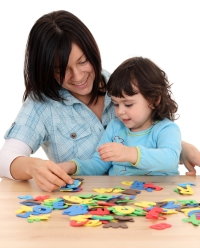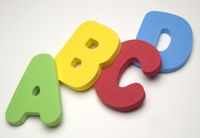Suggested Activities for kids: encouraging speech with
the alphabet
by Kate Downs
Is your toddler quiet? Does he or she seem disinterested in
speaking to assert an opinion? Have you noticed other children,
even younger than yours, with a great command of basic
vocabulary? Instead of losing sleep over the possible cause of
your child’s delay, you might want to consider a new approach to
aiding your child’s language development.
 A child’s delayed verbal capacity can be a source of great
anxiety for parents. In the age of Autism awareness, failure to
reach language development milestones can cause stomach-turning
concern for parents. The stress of this concern increases
exponentially when their pediatrician suggests they ‘keep an
eye’ on the situation. A child’s delayed verbal capacity can be a source of great
anxiety for parents. In the age of Autism awareness, failure to
reach language development milestones can cause stomach-turning
concern for parents. The stress of this concern increases
exponentially when their pediatrician suggests they ‘keep an
eye’ on the situation.
Concern is only natural when we suspect our children may be
suffering. However, the anxiety that accompanies the suggestion
of Autism is a burden too many parents are being prematurely
saddled with. Language deficits may have biological roots, but
are also commonly the result of emotional or environmental
barriers.
Parents can help their struggling or disinterested child to
achieve communication by participating in learning activities
that put success within their child’s reach. Introducing your
toddler to the alphabet, even prior to their attaining verbal
skills, can help them learn the building blocks of speech as no
other tool can.
It may be difficult to believe that your child is ready to learn
the alphabet when you have been trying for nearly two years to
teach them “bye-bye”. However, the speed with which many
children memorize the alphabet is shocking for parents. Proud
mothers and fathers have posted home videos of their young
children reciting the alphabet all over the internet. The visual
proof exists. Not only can it be done, the advantages of
teaching your child the alphabet are numerous.
Unique Advantages of the Alphabet
Like most parents facing this situation, you have probably tried
traditional methods to encourage your child’s language
development. You talk and sing to your child. You likely make
reading part of your daily routine. You may even have purchased
a dozen books designed specifically to teach first words. If
these steps have failed to improve your child’s communication
skills, the unique advantages of the alphabet may be just what
he or she needs.
The alphabet can serve as training wheels for the complex
vehicle of language. Most letters of the alphabet are easily
reproduced. Their pronunciation requires less mechanical skill
than even the simplest words.
The true complexity of words becomes clear when we compare the
construction of the word “ball” to that of the letter “B”. Where
“ball” requires the mastery of three unique sounds, the letter
“B” requires only two. Many letters require only one unique
sound. Through the alphabet, children are able to learn and
practice one twist of the tongue at a time.
 Not only are letters easier to reproduce, they offer struggling
children a faster return on their efforts. If two years of
unsuccessful attempts at “bye-bye” have you feeling discouraged,
imagine how your child feels. Using the alphabet puts these
first language accomplishments within reach. Success serves as a
powerful motivator in the learning process and helps to build
self-esteem. Likewise, continued failures serve to disinterest
children and cause them to doubt their own abilities.
Self-confidence builds with the mastery of every new letter and
children become more comfortable experimenting with sound
combinations. Not only are letters easier to reproduce, they offer struggling
children a faster return on their efforts. If two years of
unsuccessful attempts at “bye-bye” have you feeling discouraged,
imagine how your child feels. Using the alphabet puts these
first language accomplishments within reach. Success serves as a
powerful motivator in the learning process and helps to build
self-esteem. Likewise, continued failures serve to disinterest
children and cause them to doubt their own abilities.
Self-confidence builds with the mastery of every new letter and
children become more comfortable experimenting with sound
combinations.
Another unique benefit of the alphabet is the singular focus on
associating shapes with simple sounds. When children endeavor to
learn objects, they are forced to consider much more than the
object and its name. For example, “ball” may seem like a simple
concept, but in our earliest learning experiences with a ball
its name is only one of its many intricacies. Long before a
child will learn to name a ball, they will learn its
characteristics: its usefulness, how to physically interact with
it, and the basic rules associated with its use. A child will be
reminded and distracted by these lessons every time they see a
familiar object.
Letters are different. To your child, they have no purpose and
no rules. The only consequence associated with letters is the
praise a child receives for recognizing and pronouncing them.
For the purposes of enabling verbalization, letters require no
association or context. The alphabet, itself, presents no
intellectual distraction. It is not important that a toddler
knows the aural function of letters in order to progress
linguistically.
Additionally, a child’s opportunities to practice the alphabet
are unlimited. Because letters appear so frequently in their
universe children can and do continue their lessons
independently. Your may have thumbed through their picture book
countless times, but the book holds new interest as a child
recognizes familiar shapes in the text. Letters appear on
packaging, appliances, doors, television, and more. In fact,
almost every facet of your child’s universe offers them the
chance to practice the alphabet.
The simplicity of the alphabet and its multitude of learning
opportunities allows your child to practice developing speech
with no pressure and little emotional involvement. Unlike “hi”
or “bye-bye”, it does not require an understanding of social
propriety. Where objects can arouse wanting or even fear,
letters carry little emotional attachment for children. Because
a toddler doesn’t understand a letter as a tool, their
memorization does not require a comprehension of cause and
effect. Children are freed from the stress of learning language
by the utter uselessness of letters in their lives.
How to Start
Quality learning materials are available to parents in
abundance. A walk through the education section of any bookstore
will present an endless selection of puzzles, flashcards, and
word association games. However, these materials can be costly
and may fail to capture or sustain your toddler’s interest.
Children’s television programming is another powerful learning
tool, but may not serve well as an introduction to the alphabet.
The lessons provided are not concentrated and it is difficult
for small children to focus on learning when material is
presented in a mass of entertainment. However, once your child
begins to recognize those bizarre shapes, this form of education
will be more effective.
Perhaps the best tool available to parents is their own
computer. Many websites exist for the specific purpose of
educating infants and toddlers. In order to attract visitors,
many baby-oriented corporations have invested heavily in the
development of free online learning games.
Of these corporate websites, Fisher-Price may provide the best
early introduction to the alphabet. The company’s “ABC’s Zoo
Learning Game” for infants provides a clear and entertaining
review of letters and their names. Children are presented with a
single letter and short animal animations as a narrator clearly
speaks the letter name and the animal’s name. Even better, the
infant version of the game allows your child to advance letters
by pressing any key, rather than requiring the ability to use a
mouse.
for infants provides a clear and entertaining
review of letters and their names. Children are presented with a
single letter and short animal animations as a narrator clearly
speaks the letter name and the animal’s name. Even better, the
infant version of the game allows your child to advance letters
by pressing any key, rather than requiring the ability to use a
mouse.
Youtube is another
fantastic source of learning material. A simple keyword search
will provide clips of educational material from popular modern
and vintage children’s programming. You may find your child
enjoys the same images and songs you learned from as a child.
However you choose to begin the process, remember that teaching
your child the alphabet will take practice. Parents should
provide a variety of learning tools as their child will likely
tire of even the most captivating games. Patience, reward and
repetition are the keys to a positive learning environment, no
matter which environment you choose.
|